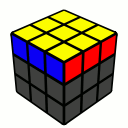 Because edge orientation is solved during EOLine and preserved during F2L,
the last layer edges will always be oriented. This provides great number of
options, ranging from a simple 20 algorithm 2-look system, all the
way up to a 1-look system with up to 493 algorithms to learn.
Because edge orientation is solved during EOLine and preserved during F2L,
the last layer edges will always be oriented. This provides great number of
options, ranging from a simple 20 algorithm 2-look system, all the
way up to a 1-look system with up to 493 algorithms to learn.
Back to Main Page
The easiest way to complete the last layer is using
OCLL/PLL: This orients the last layer corners in one
step (OCLL), then permutes the last layer corners and edges
simultaneously in the final step (PLL). This is similar to
Fridrich's OLL/PLL last layer, but much fewer OLL algorithms are
required since the last layer edges are already oriented. OCLL requires
a minimum of 6 algorithms and PLL requires a minimum of 14, giving a
total of 20 algorithms for both steps.
The average move count is 7.93 for OCLL and
11.21 for PLL which gives a total of 19.14 moves
average.[10]
If just starting out, and learning PLL is too many algorithms it
is possible to reduce the number by breaking it down into two steps - known
as 2-look PLL. It uses just 6 algorithms.
The first step uses one of 2 algs to permute the corners,
and the second step then uses one of 4 algs to permute the edges.
Algorithms:
Once comfortable with OCLL/PLL there are many more advanced ways to complete the last layer, including the possibility of a 1-look last layer using ZBLL. More information is available in the full version of this tutorial.
Algorithms:
- speedsolving.com wiki: OCLL
- speedsolving.com wiki: PLL
- AlgDB.Net PLL
- Badmephisto's 2-Look PLL Guide
- Algorithms for 4-Look Last Layer (OCLL and 2-look PLL)
NOTE: Ignore edge orientation section.
Once comfortable with OCLL/PLL there are many more advanced ways to complete the last layer, including the possibility of a 1-look last layer using ZBLL. More information is available in the full version of this tutorial.
Last updated: 7th August 2016